By now, most have heard of the trend called sugaring. As part of the growing trend to be more conscious about what goes in and on the body, many consumers have turned to body sugaring as a more skin-friendly choice for hair removal. Not only is it a simple and effective service, but the return on investment for both client and practitioner is monumental.
BENEFITS
The Paste: While sugar pastes will vary by manufacturer, when compared to traditional waxes, they are a more natural product and can be formulated without parabens, ureas, and other undesirable ingredients. Prioritizing good-for-skin ingredients like sugar, lemon, and water enhances the client’s results and a spa’s business reputation. For professionals, a quality sugar paste can offer gainful rewards. High-quality sugar paste formulations are less likely to break down during treatments, allowing professionals to use less product per client. Less product means more services.
100 Percent Hygienic: The combination of paste formulation and best practices allows professional body sugaring treatments to boast being 100 percent hygienic. Because of the high concentration of sugar found in pastes, bacteria will not breed, eliminating the chance of cross-contamination. Combined with the practice of wearing gloves on both hands and discarding used paste after each client is treated, sugaring is an ideal choice for spa owners and aestheticians.
Fewer Ingrown Hairs: Professional body sugaring removes hair in its natural direction of growth. This decreases the chances of the hair breaking upon extraction, which is often the cause of ingrown hairs. In addition, sugaring treatments are also a great source of exfoliation and regular appointments help reduce the risk of ingrowns and keep the client’s skin soft and smooth.
Less Time Between Treatments: With the proper sugaring technique, professionals can remove hair as short as one-sixteenth of an inch, meaning less wait time between treatments. The application of paste seeped into the hair follicle, followed by removal in the natural direction of growth, allows for superior results, as hairs are sugared much shorter than what is practiced in other forms of hair removal.
Permanent Hair Reduction: Probably the biggest secret of body sugaring is that regular treatments can lead to permanent hair reduction. Again, the proper technique is key in removing short hairs in the earliest stages of the growth cycle. Over time, consistent treatments deplete the hair follicle, leading to permanent reduction and lasting smoothness for clients.
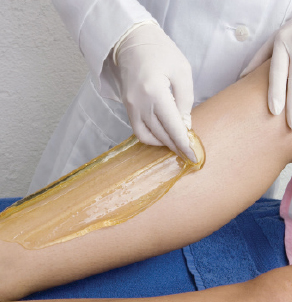 BEST PRACTICES
BEST PRACTICES
With any professional beauty care treatment, companies, salons, and people all develop different steps and practices for essentially the same routine. The same goes for body sugaring. One professional might be trained with a different set of instructions or practices compared to a professional certified from a different company. Having said this, there are a couple of best practices that anyone performing professional body sugaring treatments should follow.
Proper Ergonomics: Practitioners who perform body sugaring treatments should try to learn sugaring techniques that will help extend the longevity of their working hand, including areas like the wrist, elbow, and shoulder. There are several different sugaring techniques out on the market today, but they should not all be treated as equal. Anyone in the industry knows that sugaring can take a toll on the body. Finding the technique that works best with the body’s natural ergonomics is key to achieving a long and prosperous career.
Patch Tests: Vellus hair can be found all over the body and, while it is the lightest and thinnest of hair types, many people still wish to remove it for personal reasons. Anytime a client wishes to book a sugaring treatment for areas that contain vellus hair, professionals should always perform a patch test first. The reason for this is the removal of vellus hair can often result in histamine reactions, because the hair sits on top of nerve endings. By performing a patch test, the client is given the time to see if they are likely to react to a full treatment and how severe this reaction may be. From here, it is up to the client to decide if they would like to move forward and book the full service. The most commons areas for hair removal that contain vellus hairs are the face, chest, back, and arms. If a client chooses to forgo a patch test for these areas, have them sign a waiver stating they understand their skin might have a reaction and that the professional performing the treatment will not be held liable.
Gloves on Both Hands: Professionals are constantly moving and touching various things throughout the day. Even though certain formulations of sugar pastes can prevent the breeding of bacteria, professionals should always wear gloves on both hands when performing treatments. This practice provides further protection from cross-contamination from either the client’s skin to the professional or vice versa.
Pre- and Post-Care: Protocols for pre- and post-treatment care are created for a reason. Often, pre-treatment protocols are put in place in order to properly prepare the skin before sugaring. As for post-treatment, these protocols often involve products that help extend the results of sugaring. Standard procedures should be non-negotiable when it comes to providing a client with the best sugaring experience possible.
Sanitary Procedures: This practice does not apply strictly to sugaring hair removal and should be followed regardless of an aesthetician’s area of focus for treatments. Any time a new client is brought into the treatment room, professionals should ensure that everything has been wiped down and cleaned using the appropriate products and methods. This includes any equipment that was previously used and, especially, any massage tables or beds on which a previous client was lying.
Manufacturer Recommendations: An excellent manufacturer will provide treatment protocols for any aesthetician or professional using their products. This should be common practice for both product and equipment usage. Professionals should always follow these recommendations to ensure treatments go smoothly and without any complications due to improper use. If a manufacturer does not provide recommended treatment protocols, professionals should consider looking for another brand to make sure they are receiving the best possible products for their services.
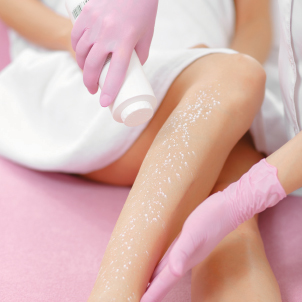 PRE- AND POST-TREATMENT CARE
PRE- AND POST-TREATMENT CARE
There are several options available in the hair removal industry for pre- and post- treatment care, but how does a professional choose which is best for his or her services? When it comes to sugaring, there are basic functions to look for in effective pre- and post-treatment procedures.
Pre-Treatment
Before beginning a sugaring service, make sure the skin is properly cleansed and prepared for an optimal treatment. Here are three steps every professional should always include.
Cleanse: The client’s skin should always be free of dirt, makeup, and oils prior to sugaring. An antimicrobial, perfume-free product that gently cleans the skin is ideal. This first step ensures there is nothing on the skin to act as a barrier or to fight against the sugar paste as it is being applied.
Soothe and Calm: Ideally, for this step, professionals should look for products with antibacterial and anti-inflammatory properties to help soothe and calm the skin prior to sugaring. Even though body sugaring is a gentle form of hair removal, it is a good idea to include a pre-treatment product that is anti-inflammatory.
Apply Drying Powder: The final step before moving on to the sugaring treatment is to apply some type of drying powder to help expose the finer hairs and ensure the skin is dry for the application of the sugar paste. If the skin is wet or oily, the sugar paste has a harder time sticking to the hairs. Products for this step should be aluminum-free and, if possible, talc- and gluten-free to prevent allergic reactions in clients.
In addition to these steps, professionals should also make sure clients are aware of a couple of pre-treatment suggestions.
Clients should not exfoliate immediately before, or the day after, a treatment. Body sugaring provides exfoliation while removing the hair and if clients exfoliate too much prior to a treatment, this can lead to skin irritation.
Ask clients what medications they are on prior to treatments to see if anything may cause increased sensitivity.
Clients undergoing Retin A treatments should not be sugared unless they have passed the five to six week mark or it has been at least 28 days since they have discontinued treatments. Clients taking Acutane should not be sugared, as the high dosage of vitamin A affects the entire body. Clients should not tan or exercise prior to sugaring treatments.
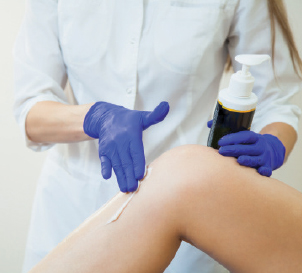 Post-Treatment
Post-Treatment
After sugaring, professionals want to ensure the results from the treatment last as long as possible. In addition, they want the client’s skin to look and feel its best. To ensure this happens, the following steps should always be performed.
Cleanse the Skin of any Residue: This step is very simple but should always be followed. Following sugaring, look over the treatment area and gently wash off any sugar residue with a warm cloth or towel. Do not use a hot cloth or towel, as this can cause irritation of the treatment area.
Soothe and Calm the Skin: This step is identical to the second step in the pre-treatment section. The goal here is to find products that are anti-inflammatory, antibacterial, and antimicrobial to help calm and soothe the skin, while also reducing any redness that might be present.
Hydrate: Sugaring does more than just remove unwanted hair. It also exfoliates. Once a treatment is complete, the final post-care step is to make sure the client’s skin is well hydrated to give that silky look and feel.
Beyond these basic steps, professionals should make their clients aware of rules they should follow for 24 hours post-treatment.
Clients should not workout immediately after a treatment. It would be a good idea for clients to avoid exercise to prevent any chaffing or irritation of the newly sugared skin caused by sweating and heat friction.
Clients should not tan or go into the sun for long-periods of time immediately after a treatment. As mentioned, sugaring is also a form of exfoliation which can leave the skin more sensitive to ultraviolet radiation, increasing the client’s risk of sunburn.
Clients should not exfoliate until at least the day after treatment and, even then, they should be gentler on the treatment area or forgo it altogether. If the client is not careful, their skin can become irritated due to over exfoliation.
The steps listed above are the bare-bones that every sugaring professional should include with their treatments. From here, products or steps can be added as the professional sees fit. For example, if available, a natural product to reduce the discomfort that can accompany hair removal is also highly recommended. This type of product could be something applied as part of pre-treatment care, post-treatment care, or both.
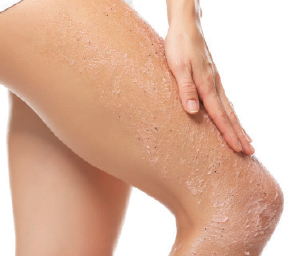 HOMECARE FOR CLIENTS
HOMECARE FOR CLIENTS
When it comes to sugaring hair removal services, the client’s homecare regimen is nearly as important as the sugaring treatment itself. It is important for professionals to be able to properly educate their clients on what they should be doing between visits, to not only prolong their results, but also to improve the experience and results of the treatments.
There are two steps all sugaring clients should be doing at home: exfoliation and hydration.
Exfoliation
While exfoliation plays a large role in removing dead skin to reveal the healthy and bright skin underneath, it is even more important for the hair growth that occurs between appointments. As the hair begins to grow back, clients want to make sure the hair does not get trapped underneath a layer of dead skin. This can lead to problems such as congestion and ingrown hairs. Should a client return for a sugaring treatment with trapped hair due to lack of exfoliation, much of the treatment will be spent trying to free those hairs and the client may leave disappointed with the results.
Regular at-home exfoliation using scrubs or exfoliating gloves can help ensure hairs do not get trapped below the surface. This means that when clients come for their next treatment, professionals will have a much easier time removing the hair and the client will leave with the desired results.
Hydration
Just like exfoliation, proper skin hydration is key if clients want to achieve optimum results. Proper hydration helps keep dryness at bay, which, in turn, will help prevent hairs from getting trapped under the skin. When a client comes in with healthy, hydrated skin, the sugar paste has an easier time wrapping around the hair, allowing for easy extraction.
Professionals can only control about three quarters of the factors that affect a client’s sugaring results. The other quarter is entirely dependent on how dedicated clients are to their homecare regimen. Can good results be achieved with treatments alone? Yes, but for optimum results, professionals need to provide their clients with the knowledge and products needed to reach their skin’s best condition.
With proper pre- and post-treatment care and incorporation of best practices, professionals will be able to deliver the sweet benefits that accompany sugaring services to their clients.
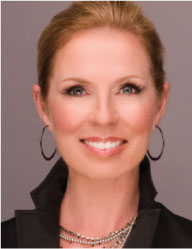 Lina Kennedy is a chief pioneer, collecting many feathers in her cap. An expert on professional sugaring, Kennedy regularly writes articles for industry magazines in North America and Europe. As president of Alexandria Professional, one of her personal goals is to ensure that each professional trained in the art of body sugaring learns and understands the exceptional results that they and their clients can achieve through The Kennedy Theory™ for sugaring and The Kennedy Technique Theory™.
Lina Kennedy is a chief pioneer, collecting many feathers in her cap. An expert on professional sugaring, Kennedy regularly writes articles for industry magazines in North America and Europe. As president of Alexandria Professional, one of her personal goals is to ensure that each professional trained in the art of body sugaring learns and understands the exceptional results that they and their clients can achieve through The Kennedy Theory™ for sugaring and The Kennedy Technique Theory™.